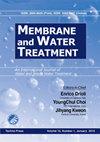Impact of DBPs on the fate of zebrafish; Behavioral and lipid profile changes
IF 1.1
4区 工程技术
Q4 ENGINEERING, CHEMICAL
引用次数: 3
Abstract
In recent years, the generation of disinfectant by-products (DBPs) in drinking water system has been highlighted for their potential negative impact on humans. A commonly used disinfectant, chlorine, produces a by-product which is highly hazardous and a known carcinogen. This study investigated the toxic effects of DBPs from several organic matter as a function of contact time with chlorine-based disinfectants were investigated using zebrafish. The results indicated that the generation of DBPs was dependent on the composition of dissolved organic matter (DOM) in water. Suwannee river natural organic matter and experimental site water sample (complex DOM) were almost 2.5 times higher than that of a single dissolved organic matter, such as microcystin-LR (MCLR) at 120 min. The behavior of zebrafish was significantly affected by complex composition DOM. In vivo biomarker analysis result from lipid profile analysis, reaction in vivo showed different depending on the composition of the DOM. Through this study, the effect of DBPs were observed via lipid metabolic and movement changes in aquatic organisms can be considered as a new biomarker for the drinking water risk assessment.DBPs对斑马鱼命运的影响;行为和脂质状况变化
近年来,饮用水系统中产生的消毒副产物(DBPs)因其对人类的潜在负面影响而备受关注。一种常用的消毒剂氯会产生一种副产品,这种副产品具有高度危险性,是一种已知的致癌物。本研究以斑马鱼为研究对象,研究了几种有机物对DBP的毒性作用,以及与氯基消毒剂接触时间的函数关系。结果表明,DBPs的生成与水中溶解有机物的组成有关。Suwannee河天然有机物和实验场地水样(复合DOM)在120分钟时几乎是单一溶解有机物(如微囊藻毒素LR)的2.5倍。复合DOM显著影响斑马鱼的行为。脂质图谱分析的体内生物标志物分析结果显示,体内反应因DOM的组成而异。通过这项研究,通过水生生物的脂质代谢和运动变化来观察DBPs的作用,可以认为这是一种新的饮用水风险评估生物标志物。
本文章由计算机程序翻译,如有差异,请以英文原文为准。
求助全文
约1分钟内获得全文
求助全文
来源期刊

Membrane Water Treatment
ENGINEERING, CHEMICAL-WATER RESOURCES
CiteScore
1.90
自引率
30.00%
发文量
0
审稿时长
>12 weeks
期刊介绍:
The Membrane and Water Treatment(MWT), An International Journal, aims at opening an access to the valuable source of technical information and providing an excellent publication channel for the global community of researchers in Membrane and Water Treatment related area. Specific emphasis of the journal may include but not limited to; the engineering and scientific aspects of understanding the basic mechanisms and applying membranes for water and waste water treatment, such as transport phenomena, surface characteristics, fouling, scaling, desalination, membrane bioreactors, water reuse, and system optimization.
 求助内容:
求助内容: 应助结果提醒方式:
应助结果提醒方式:


